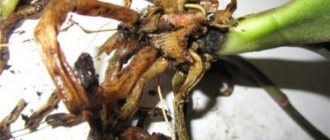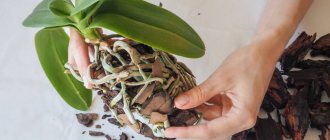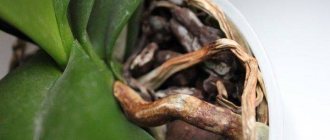What is root rot and what does it look like?
Root rotting is a common disease, which is usually caused by improper flower care or attack by harmful microorganisms. Rot occurs mainly in the cold season, when daylight hours decrease and air temperature drops. Rot, if the process is not too advanced, can be treated. And you should only throw away a diseased flower as a last resort.
Healthy roots are light green or pale gray. When moistened with water, the color acquires a rich, dark shade. Diseased roots are dark brown, pale yellow with a white coating.
How to care for it to preserve it?
When revived by any method, the plants are provided with ideal environmental conditions: twelve-hour daylight hours, diffused lighting and an air temperature of 20-27 degrees. During the period of root system restoration:
- Reduce the amount of nitrogen in fertilizing.
- If the flower lacks moisture and the leaves lose turgor, they are sprayed.
- Provide regular but meager watering.
In a favorable environment, the orchid will begin to grow roots almost immediately after transplantation. Small flowers will restore the root system in 2-3 months, large specimens will need about six months. Until the plant's health is restored, it will not grow or bloom.
How to distinguish healthy roots from rotten ones?
The first condition for a healthy root is hardness and elasticity. And accordingly, on the contrary, if the root is soft, breaks when pressed or dents remain, most likely it is not functional. External signs of a healthy rhizome:
- smooth structure;
- fleshiness;
- density;
- green, although the color may change when interacting with the substrate or mineral fertilizers.
Experienced gardeners suggest checking the condition of the root system, not only based on external signs, but also experimentally. To make sure that the root system is alive, you need to remove the plant from the flowerpot and immerse the lower part in water. After 2-3 hours, take it out. Viable roots will acquire the above characteristics. If the sprouts remain limp and pale, feel free to remove them.
Determining the condition of the roots solely by color is wrong. It is important to examine their physical condition.
We invite you to watch a video on how to distinguish healthy orchid roots from rotten ones:
Rules for transplantation and care
The orchid is planted in a new container and fresh substrate when the newly grown roots reach a length of 5-6 cm. The rules for planting and caring for a plant with undeveloped roots are as follows:
- The container is selected in a size that corresponds to the root system, regardless of the size of the outlet. If you have several roots, a pot with a diameter of 10 cm is enough so that the upper part does not outweigh, you should choose a pot with a weighted bottom.
- Drainage is placed at the bottom of the prepared pot, and a little sphagnum moss is placed on it. Then a plant is placed in the center.
- Gradually, the space between the roots is filled with nutritious, loose substrate. The bottom layer is vermiculite (1/4 of the height), then sphagnum (2-3 cm), large pieces of pine bark (1"/ height), a mixture of small pieces of bark, coconut fiber and charcoal (fraction size 1 cm).
- The first watering is carried out after 5-7 days. Excessive moistening of the substrate for 2 months is not recommended, so the substrate is sprayed with a spray bottle.
- The reanimated orchid needs intense lighting, but it cannot be kept in the sun. Daylight hours are at least 12 hours a day.
- To maintain moisture, the leaves are sprayed with warm water every morning.
Important! Fertilizing begins only after new shoots appear on the plant or a flower arrow begins to form. Fertilize the orchid by leaves with mixtures containing a high nitrogen content.
If an orchid has lost its roots, resuscitation must be started as early as possible, then the plant can quickly recover.
The flower is quite capricious, but surprisingly tenacious, so beginners should not worry about destroying it with their actions.
5 / 5 ( 1 voice )
Effect on the whole plant
The root is an organ in orchids that is responsible for vital processes. Firstly, the flower is attached to the substrate by its roots, thereby maintaining a vertical position. Secondly, the roots absorb moisture and micronutrients that are in the soil. Thirdly, they, together with the leaves, participate in the process of photosynthesis. One can only imagine what will happen to a flower without a root system.
Rotting is best treated when the disease is at an early stage. Having recognized the symptoms later, it is unlikely that it will be possible to save the exotic from death.
Important. Use a transparent pot to plant your orchid to regularly check the condition of the root system.
Why did this happen?
Before you start treating a flower, you need to determine the reason why its roots have rotted. They may be as follows:
- excessive watering;
- bad light;
- the substrate is too dense, the substrate is of low quality or the composition is not suitable for the plant;
- excess fertilizer;
- fungal diseases or pests.
These reasons are discussed in more detail below.
Overwatering
The orchid has a special watering regime at different times of the year; in addition, only soft and warm water should be used to water the plant. If the plant is watered frequently, the substrate does not have time to dry out, therefore, the roots inside it begin to rot. If you do not respond to the problem in time, rotting can cover the entire root system and can also damage the root collar of the bush, which is quite dangerous.
Important! The irrigation system should be organized in such a way that the substrate dries out between waterings in about a couple of days.
The first sign of rotting orchid roots is a change in color of the lower pair of leaf plates to yellow.
Lack of proper lighting
Watering and lighting of an orchid are inextricably linked . Filling of the cellular structure of the roots occurs gradually, then moisture enters the exodermis, and if the plant is in the shade, it will not absorb water in sufficient quantities. Therefore, the orchid needs sufficient lighting, especially in winter.
Most often, rotting of the roots of an orchid is observed in winter; this is a dangerous period for the root system - lack of light and too wet a substrate provoke rotting of the root system.
Poor quality or too dense soil
Over time, the soil in the pot becomes crushed and compacted, resulting in it becoming too heavy and dense.
This phenomenon causes stagnation of water, therefore, the roots are constantly in water, do not receive oxygen and rot. Therefore, there should be no small particles in the orchid substrate .
In addition, the owner of the plant must use high-quality mixtures for planting orchids, and if the store does not have special soil for orchids, it can be prepared independently from boiled pine bark and sphagnum.
Excessive fertilization
Orchids have very delicate roots, so they are easy to burn if the concentration of fertilizing is not chosen correctly. This is especially true for phosphorus and potassium fertilizers. The surface layer of the roots is damaged, and the plant ceases to receive sufficient nutrition.
Fungal diseases or pests
The orchid is extremely susceptible to various diseases. Most often it suffers from black rot, fungal infections come in second place, and viruses come in third. The roots can also rot as a result of attack by click beetles.
Fungal diseases:
- Late blight is caused by the fungi Phytophthora nicotianae, Phytophthora palmivora, Phytophthora cactorum, Phytophthora cinnamomi and others. Unpleasant diseases of the root system, which are provoked by high humidity and temperatures above 25 degrees. If action is not taken quickly, the plant may die within 2-3 days.
- Rhizoctonia blight - caused by soil fungi Rhizoctonia solani, which gets on roots with infected bark. It spreads very quickly, especially in high humidity.
- Southern sclerotial rot is caused by the fungus Sclerotium rolfsii, a very viable infection that is almost impossible to defeat. Penetrates to the roots through contaminated substrate and water.
Others
Sometimes orchid roots are damaged during transplantation. If damaged roots are not treated immediately, the risk of rot increases, and the infection will quickly spread throughout the entire root system.
Watch the video that talks about the reasons why the roots of an orchid can rot:
How to identify the disease at an early stage?
If you regularly examine your orchid, the following symptoms may alert you during the next check:
- leaves began to turn yellow and fall off en masse;
- buds and flowers fall off;
- the appearance of dark spots on the foliage;
- the orchid leaned on its side;
- the flower is unstable in the pot;
- black or dark brown areas of roots are noticeable;
- liquid leaks from the rhizome;
- possible presence of mucous membrane;
- roots are damp to the touch;
- there is a distinct putrid odor.
In what situations can roots rot?
There are standard prerequisites for the appearance of rot:
- The presence of sphagnum moss in the pot. When growing adult orchids, it can cause waterlogging, acidification of the substrate, and disruption of air exchange. This creates conditions for fungal and bacterial infection of the flower, and it can rot.
- Root rotting at the base. The reason for this process is frequent watering, temperature changes, overheating, and damage during transplantation.
- Damage to young roots. They often suffer from fungal infections, excessive watering, and burns when applying fertilizers.
Photo
Below you can see what rotting roots look like:
How to treat rotting at home?
To help an exotic plant and choose the right treatment, you should first determine the cause of the rot, and only then use this or that remedy.
Chemical
If it turns out that the cause of rotting of the root system is pests (whiteflies, midges, scale insects, thrips) or viral diseases, then acaricides or insecticides will be useful, such as:
- "Aktara";
- "Tsvetofos";
- "Fufan";
- "Inta-vir";
- "Vermitek".
For fungal infections, fungicides are indispensable. The most effective drugs for prevention and treatment are fungicides, which destroy pathogens of fungal diseases in flora. They come in different spectrums of action. The main active substances of fungicides are: aldehydes, mercury, copper, manganese, organic substances.
- "Oxychom";
- "Fundazol";
- "Immunotitophyte";
- "Fitosporin";
- "Topas".
Folk
What can you do at home to save rotting roots? Homemade recipes are products that have been proven over the years. Yes, they do not have the same degree of damage as industrial ones, but they are more affordable and environmentally friendly.
- A decoction of cyclamen tubers. For preparation you will need finely chopped flower tubers. It is recommended to boil them over low heat for 30-40 minutes. Leave for a day. Afterwards, strain the broth and dip the diseased orchid roots into it for 5-10 minutes.
- Soap solution. Dissolve 1 bar of laundry soap in 3 liters of clean warm water. Then immerse the roots in the soapy solution for a few minutes.
- Oil solution. Dissolve 2 tablespoons of olive oil in 1 liter of water. You can immerse the orchid roots in the resulting mixture.
- Onion infusion. Cook 3-4 small onions for 30 minutes. Then cool the broth and leave for a day. Clean flower roots should be left in the medicinal liquid for 7-10 minutes.
Important. Folk remedies can only help in the early stages of the disease.
Step-by-step recommendations: what to do for various reasons and how to save a flower?
For pests
How to save a flower if the roots begin to rot due to pests? Waterlogged soil is a suitable breeding ground for pests. Such, for example, as fools. These insects are constantly on the move. They feed on decaying plant tissue. The appearance of these little white bugs indicates the presence of rotting. How to fight:
- Place the diseased plant in quarantine, and disinfect the place where the pot was.
- Remove the orchid from the flowerpot and remove excess soil from the roots.
- Wash and then dry the rhizome under running water.
- Remove damaged areas of roots with a sharp, disinfected instrument.
- If the infection is not severe, then it is worth trying one of the folk remedies.
- For larger problems, the flower must be treated with an insecticide solution.
- Leave for 2 days without substrate. It is advisable to wrap the roots in polyethylene to achieve a greenhouse effect. In such conditions, pests will be destroyed.
- Remove the plant to a dark, cool place.
- Make sure that steaming does not occur, otherwise other problems await the orchid.
- After all the procedures performed, the plant is planted in new soil.
Substrate compaction
The fresh substrate contains natural elements that do not adhere tightly to each other. Thus, an air layer is created, due to which the roots have access to oxygen. However, over time, the tree bark contained in the composition delaminates, and accordingly the soil is compacted, becoming more dense. Air access is limited, resulting in rotting. How to save a plant if the roots have rotted due to compaction of the substrate:
- Carefully remove the flower from the pot and remove any remaining soil.
- Rinse the roots under running warm water.
- Trim damaged areas of roots.
- Treat the sections with an antiseptic.
- Replant the orchid in a new substrate.
- Use exclusively purified, soft water for irrigation.
- Renew the soil every three years, at least.
It is important that the soil mixture is loose, light and contains the maximum amount of coarse particles.
For fungal diseases
If the roots of an orchid are rotting, and spots of a characteristic yellow color with a rotten center are noticeable on the leaves, soil fungi are most likely to blame. Such diseases develop well in environments with low humidity and lack of light.
- Isolate the diseased plant.
- Remove damaged areas of roots with a sharp, disinfected instrument.
- Treat the soil and plant with a solution of a systemic fungicide.
- It is advisable to use the method of immersing the pot in a chemical mixture, if it is described in the recommendations for use of the drug.
- Repeat the procedure 3 times with a break of 10-14 days.
- The flower should be kept in a dark place for 7 days.
- Normalize the microclimate parameters in the room.
- Adjust the irrigation system.
Mechanical damage
It happens that the underground part begins to rot due to injuries caused. It is possible that some of the roots broke off during transplantation, and the wound sites were not treated with an antiseptic. Living tissue is a passage for bacteria and pathogenic microorganisms. The injured root system will begin to rot. What to do if the roots are rotten? In this case, you should replant the plant again, cut off the rotten areas and be sure to disinfect them. Then place the exotic in soil enriched with minerals and provide proper care.
Using too concentrated fertilizers
The root system of orchids is quite sensitive to the effects of potassium and phosphorus salts found in concentrated fertilizers. And if you deliberately increase the frequency of applications, it is possible that the roots will be burned. In this state, they cannot absorb water, and when in damp soil, they swell and rot.
- We take the flower out of the old pot.
- Immerse the lower part of the plant in a container of warm water and leave for 2 hours.
- Gently wipe the roots with a paper towel.
- Damaged areas are removed and disinfected.
- We transplant the orchid into a transparent pot.
- For the first 1-2 months, we exclude fertilizers completely.
If the content is too wet
It is not paradoxical, but being constantly in wet soil, the root system cannot be saturated with water. The soil should dry out completely between waterings. The sun's rays should hit the soil and dry it. The main condition for replenishing the roots with water is light. If there is not enough of it, the leaves do not have enough moisture and the roots rot. What to do if the orchid is heavily flooded and the roots begin to rot, how to keep the flower alive? Measures taken in this case:
- Remove the orchid from the pot.
- Clean the root system from soil residues and rinse with warm water.
- Remove sore spots and treat sections with crushed activated carbon.
- Leave the flower to dry overnight.
- Transplant the exotic into a new substrate, with the obligatory presence of a drainage layer.
- Control the irrigation system.
The flower has no roots and leaves
When the roots of an orchid have dried out, the leaves turn yellow and rot, not all is lost, there is a good, but labor-intensive option for salvation. You should purchase or make a small plastic greenhouse, pour expanded clay onto the bottom of the pot, and lay moss on top of it. After critical pruning, the plant must be treated with crushed coal and placed on sphagnum moss. What to do next:
- install a phyto-lamp to provide the plant with light for 12–14 hours;
- periodically soak the flower in a nutrient mixture (growth regulator, once a month) and plain water;
- treat with growth stimulants the places where leaves and roots should hatch;
- Periodically, the orchid needs to be dipped into special solutions for 5–15 minutes.
Attention!
When growing roots and leaves, you should not expect quick results; recovery can take a long time (from several months to a year). If all the leaves of a plant have rotted along with the roots, growing point and root collar, it will no longer be possible to save it.
B vitamins are suitable for “bathing” and processing; they contribute to the rapid restoration of rotten roots; soaking should be done once a month, and wiping every 7 days. As fertilizers, you need to use mixtures based on phosphorus and potassium, as well as microfertilizers with chelate, but in small doses and no more than once every 60 days. An orchid needs glucose at all stages of recovery; a healthy flower produces it independently. The substance can be mixed with fertilizers.
Step-by-step instructions on how to revive a plant
What to do if an orchid that has been recently purchased or has been growing at home for a long time has completely rotten roots and yellowed leaves, how to carry out resuscitation? Is it possible to save a flower with rotten roots? Yes, even if an indoor exotic plant has lost all its roots, this is not a reason to throw the plant in the trash. There are several ways to revive an orchid.
Without greenhouse method
- We take the exotic out of the pot.
- Remove excess substrate with a stream of warm water.
- We select a sharp, disinfected knife or pruning shears.
- We remove damaged areas with a previously prepared tool.
- Sprinkle the sections with an antiseptic that does not contain alcohol.
- We give time for the wounds to dry.
- We mix the remains of the root system into a solution of root formation stimulants.
These drugs strengthen the plant’s immunity and promote the rapid appearance of new root shoots. “Epin” or “Zircon” are considered effective. Directions for use: dilute 1 drop of the drug in 1 liter of water. In this case, the flower should arrive in about 2 hours. - Be sure to ensure that the liquid does not get on the leaves.
- Next, place the plant in a container with purified water.
- In the room where the flower is located, the temperature should be maintained at +23-25ºС.
- Mandatory use of mineral components based on potassium and phosphorus, once a week.
- Apply a root formation stimulator once every 30 days, keeping the plant in the solution for no more than 6 hours.
Greenhouse method
You can do without a greenhouse if you still have some of the roots. And when there is no root system, then you should choose the greenhouse option. We cut and process the roots in the manner described above, and then:
Take a pot and pour a thin layer of expanded clay granules.
- We lay sphagnum moss, previously disinfected, on top.
- We water everything with clean water and place a rosette of a diseased flower on top.
- We transfer it to a mini-greenhouse, where the following conditions are maintained: temperature +25-28°C, humidity within 80%, lighting for 12-14 hours a day.
- The flower should be kept in similar conditions until the roots grow 3-5 cm long.
- Afterwards, you are allowed to transplant the flower into a special substrate for orchids and remove the greenhouse.
We invite you to watch a video about a greenhouse method of resuscitating an orchid without roots:
Orchid rot is a serious problem. Read about why leaves, as well as the core, neck or other parts rot and what to do about it, on the website. There are also materials about fusarium.
Characteristic signs of illness
It is possible to revive an orchid at home, but only after correct diagnosis of the problem. To avoid any difficulties in examining the roots, it is recommended to plant the plant in transparent containers; healthy roots will be grayish-green, elastic and smooth to the touch. The fact that a mistake was made somewhere can be determined by the appearance and condition of the plant:
- the leaves have lost turgor, the situation does not change after watering;
- yellowed lower pair of leaves (a sign of overflow);
- the appearance of brown spots on leaf blades;
- falling buds;
- the inner walls of the container are covered with a coating of spores or algae;
- the roots have darkened, become brownish, dried out, or have watery, slimy areas on them. When you press on the root, liquid is released, the tissues decompose into separate “threads”;
- the bush does not hold tightly in the container and wobbles;
- complete or partial stop in development, the orchid gradually dies.
Before starting to treat a flower, you need to carefully examine the leaves for pests; they are usually clearly visible. The infected plant should be treated with an insecticide. If at least one of the described symptoms is observed, the flower should be immediately removed from the pot and appropriate measures taken. Phalaenopsis, although capricious, are distinguished by their vitality; flower growers manage to save an orchid even if all its roots have rotted, only the rosette remains. In any case, the longer the flower remains with damaged roots, the less chance of a quick recovery.
Prevention
The condition and development of the orchid directly depends on the microclimate parameters and care measures. Therefore, it is important to: control the irrigation system, update the substrate every 3 years, use high-quality water, strengthen the plant’s immunity, prevent infectious diseases, and regularly inspect the root system.
Of course, an orchid without roots can be restored, but the process is not quick and requires a lot of patience and time. Therefore, in order not to bring the flower to this state, follow all care recommendations.
If you find an error, please select a piece of text and press Ctrl+Enter.











